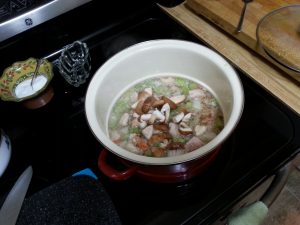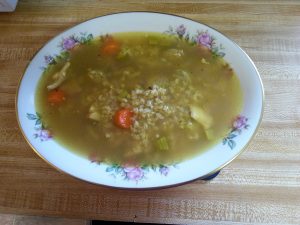
begin
Love Billings
These are foods that are like building blocks for making other dishes but can also be eaten on their own. They are great to just have on hand. And they are the kinds of foods that (assuming you have no allergy to them, and you eat them frequently) will put you ahead of the game nutritionally, even if nothing else in your diet changes.
eggs
Eggs. One versatile, inexpensive and tasty food. And if you can get eggs from hens that live mainly out in the open on pasture, we are talking nutrient-dense too. I’ve found that “Low and Slow” is the rule for getting the best results when cooking eggs.
perfect boiled eggs
Ingredients:
- 1-6 eggs
- Water
- Ice cubes
Equipment:
- Saucepan with lid
- Timer
How to:
Since this calls for precise timing, you might pull up a chair by the stove while making perfect boiled eggs. Set eggs in saucepan.

Cover them with water.

Place lid and put it on high heat.

Once at a mad roiling boil, remove from heat and let stand, lid on.

For soft-boiled, let stand for 3 minutes. For medium-boiled, let stand for 5 minutes. For hard-boiled, let stand for 6 or more minutes.

Pour off hot water and pour in cold tap water and a tray of ice cubes.

Let stand for 5 minutes.

Crack the shell and peel. The shell and inner skin will now come easily without sticking to the egg.


You can store them peeled or unpeeled in the fridge. They will keep, unpeeled, for up to six days, peeled for about four. Note that after being stored a while unpeeled, there may be some sticking of the skin to the egg. I’ve decided to store three and make egg salad out of three, throwing in some mayo, Dijon mustard, salt, pepper, smoked paprika and a touch of curry. Then chop and mix. So easy if you have one of these:

Some other uses for boiled eggs:
A simple snack as is with salt and pepper
Deviled eggs
Cobb or chef’s salad
bone broth

Bone Broth. You’ve heard of this. It’s the new fad food and supplement, right? Once you’ve made your own, you won’t believe how cheap, easy and delicious it is!
Ingredients:
Bones to fill your crock pot about ¾ full. These can be anything from bones left over from KFC dinners that you’ve saved in a ziplock baggie in the freezer to grass-fed bones you’ve purchased from a butcher. The most nutritious and tasty bones are uncooked, grass-fed beef and lamb or organic chicken bones. But any type of bone will make delicious bone broth.
- Water
- 1 tbsp apple cider vinegar
- 1 tsp or more salt
- Spices (optional)
- Chicken or turkey giblets (optional)
- Chopped celery, carrots, onion (optional)
Equipment:
- Crock pot
- Measuring spoons
- Sieve
- Ladle
- Glass storage containers such as canning jars
- Large funnel if using mason jars
- Tongs
How to:
Fill a crock pot about ¾ full with bones. Fill to the top with water, so that the bones are covered by water. I’m using beef knuckle bones here, quite fatty, but inexpensive and yielding tremendous flavor and rich collagen.

Add 1 tbsp apple cider vinegar and 1 tsp or more of salt. Add any optional spices. If you happen to have some chicken or turkey giblets around, throw them in too. They will unbelievably enhance the depth and richness of the broth.

Set on low and leave it to cook for a full 48 hours, filling it back up with water after the first 24 hours, or as needed, depending on how fast the broth seems to be cooking down. At least two hours before the end, add any optional veggies. When broth is done, unplug the pot, take the lid off and allow to cool. If you have a large crock pot, this recipe will make 4-5 quarts. To store, ladle and strain into canning jars or other containers, lifting out bones with tongs as needed. Discard the bones or use to make a second, weaker batch of broth.

Refrigerate or freeze. You can see a layer of fat already forming in the tops of a couple of my jars. The downside, perhaps, of using raw beef knuckles. When cooled and hardened, you can remove and discard this or use it as you wish. I intentionally used wide-mouth jars to be able to remove the fat layer more easily. The broth may set up into jelly when it cools, but will turn liquid when warmed.
Some ideas for use:
Heat a mug of broth in the microwave with a pinch of salt. Yum! Add some lemon juice, minced garlic and/or grated ginger, and you have a concoction that might ward off a cold!
Use instead of water when cooking rice or veggies.
Use as base for stews and soups. For example:
quick chicken soup with rice
Equipment:
- Soup pot or dutch oven
- Cutting boards
- Knives
- Measuring spoons
Ingredients:
- One and a half quarts (6 cups) of bone broth
- One 1 lb. package of boneless skinless chicken thighs
- 2 stalks celery
- Handful of baby carrots
- 1/3 of a large onion or ½ of a medium onion
- 1 tbsp minced garlic
- 1 tsp minced ginger
- ½ tsp turmeric
- ½ tsp salt or more, to taste
- Pepper to taste
- ½ c. rice
How to:
Slice chicken, celery, carrots and onion into bite-sized pieces. Place soup pot on medium heat. Add the chicken and let sear a bit. Throw in the veggies, garlic and ginger. I’ve added a few shiitake mushrooms here, just because.

Add the broth, turmeric, salt, pepper and rice. Bring just to a boil, then turn down to simmer for 30 minutes or until rice is done to taste.

Steamy comfort!

salad
Salad. I know, I don’t like salad either. But everyone is harping on you to eat your dark leafy greens, right?? I was raised eating iceberg lettuce. Easy to digest. Because it’s like – crispy water. When I first started eating salads on a regular basis, I got mild indigestion every time. It took a couple of months, but eventually a day came when I realized my body had figured out how to digest dark greens. Yaay!
So. If all you ever do is buy tubs of pre-washed mixed baby greens, plop some in a bowl, maybe throw on some vinegar and olive oil, and persist in eating this three times a week, you are there. You are eating your greens!

But of course, you will want to make this experience tastier. That is done in mere seconds by tossing on any of the following:
Nuts
Seeds
Dried cranberries or other dried fruit
Sliced radish
Sliced cucumber
Grated, shredded or julienned carrots, cabbage or other veggies (bags of these are often sold in the salad section)
Grated or minced fresh or candied ginger
Chopped or shredded leftover meat or fish
Diced or sliced lunchmeat
Sliced boiled egg
Crumbled or diced cheese
Diced apple
Sliced strawberries, seedless grapes or blueberries
Sliced or diced cooked beets
You get the idea.
A word about organic versus conventional. The problem with eating three or more good-sized salads a week is that you’re building up pesticides in your system over time if the greens are not organic. Something to study and weigh for yourself. It does seem that organic baby greens or kale, chard, collards and other dark leafies are becoming more inexpensive and more available. I hope this is the case where you do your grocery shopping.

